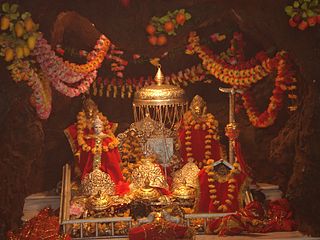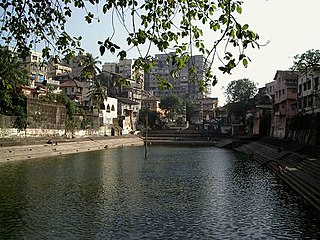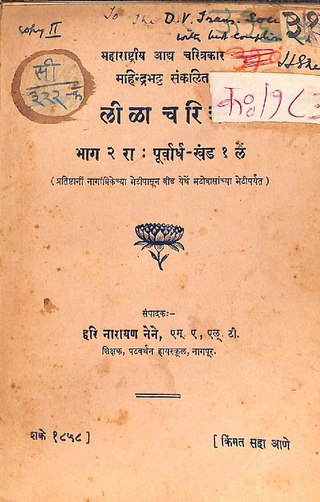
Vaishno Devi is a manifestation of the Hindu mother goddess Durga or Adi Shakti. Vaishno Devi is worshipped as a combined avatar of the goddesses Mahakali, Mahalakshmi, and Mahasaraswati.

Walkeshwar Temple, also known as the Baan Ganga Temple, is a temple dedicated to Lord Shiva located in Walkeshwar, near Malabar Hill neighbourhood, in South Mumbai precinct of the city of Mumbai, India. It is situated at the highest point of the city, and close to the temple lies the Banganga Tank.

The Banganga Tank is a temple tank which is part of the Hindu Walkeshwar Temple complex in the Malabar Hill area of the city of Mumbai, India.
The Gambhir River, which is also known as the Utangan River, is an ephemeral (seasonal) river in India which originates in Rajasthan state and confluences with Yamuna in Uttar Pradesh state. Important tributaries of the Gambhir are Banganga, Sesa, Kher, Churaho and Parbati.
Walkeshwar is an affluent area in South Mumbai, India, at the north-western end of the Marine Drive loop. It has a large Gujarati population. It is mostly known for Walkeshwar Temple, Banganga Tank and Jain temples.

Dausa District is a district of Rajasthan state in India within Jaipur division. The city of Dausa is the district headquarters. It has an area of 3432 km² and a population of 1,634,409 in 2011 census. It is surrounded by Alwar District in the north, Bharatpur district in the northeast, Karauli district in the southeast, Sawai Madhopur district in the south, and Jaipur district in the west. The Sawa and Banganga rivers run through the district. It is situated on the National Highway 21 from Jaipur to Agra. It is 55 km to the east of Jaipur and 103 km from Sawai Madhopur.
Bhoom is a town with a municipal council in Osmanabad district, Maharashtra, India, and it is the headquarters of Bhoom tahsil. Bhoom municipal corporation is established in 1948. Bhoom is a small town situated in a valley of the Banashankar hill ranges of Sahyadri. It is situated on the banks of the River Banaganga, which eventually flows into the Bhima. In 1717, Sambhaji II of Kolhapur gave Bhoom as jagir to Shrimant Senakhaskhel Yashwantrao Thorat (a chief and military leader of his troops) for his bravery. In 19th century Bhoom was under Nizam territory during the British raj in India. However it was independently ruled by the ' Thorat ' royal family. Shrimant Vijaysinh Amarsinh Thorat is the present head of Bhoom. He was the President of Bhoom Municipal Council from 1991 -2006.

Nevasa is a city in Nevasa tehsil of Ahmednagar district in the Indian state of Maharashtra. Old names of this place are Nidhinivas, Nivas and Mahalaya Also town of lord Kuber. Sant Dnyaneshwar Temple is main temple. This place is near of Pravara river, this river is also called Amritvahini.
Datyane is a village in the Niphad taluka, Nashik district of Maharashtra, India, situated on the river Banganga and on the Ozar-Kasabe Sukena connecting road. It shares borders with Narayangaon (Kherawadi) to the south, Shirasgaon to the north, Dixi and Ozar to the west and Owne and Theragaon to the east.
Banganga Tank is an ancient water tank at Walkeshwar Temple Complex in Malabar Hill area of Mumbai City
Bangai is a village development committee in Kapilvastu District in the Lumbini Zone of southern Nepal. Locally, there are two places known by the name of Bangai, Gherawa Bangain in the east and Koili Bangain in the west, separated by the distance of 1 km. Mahendra Highway or east–west highway passes through it. The Banganga river marks the south boundary of Bangain. Manoharipur is the first adjacent village in the south of it which lies in the Kopawa V.D.C. Locally, Bangain is famous for its funeral site on the bank of Banganga known as Laxmanghat. It is also a major shopping hub within 5 km of its radius due to its proximity with the highway. At the time of the 1991 Nepal census it had a population of 2983 people living in 528 individual households.
Banganga is a municipality in Kapilvastu District in the Lumbini Zone of southern Nepal. Banganga Municipality has total of 233.6 km2. According to the 2011 census, total population of the municipality is 75, 242 with population density of 322 person per km2 and density without forest is 804 persons per km2.
The Halali reservoir is a reservoir in Madhya Pradesh state of India, spanning Bhopal, Raisen, and Vidisha districts. It is built on the Halali River, and lies 40 km northwards from the state capital Bhopal.

Sahasrakund Waterfall is a waterfall on the Painganga River of Nanded district, Maharashtra, India. This town is on the boundary of the Yavatmal and Nanded districts on the Penganga river.
Banganga is a small tributary of the Godavari River in the Nashik district, in the state of Maharashtra in western India.
Banganga River, an 240 km long tributary of Gambhir river in India, originates from the hills of Aransar and Bairath in Jaipur region of Rajasthan state and converges with Yamuna near Fatehabad in Agra district of Uttar Pradesh state. Its main tributaries are Gumti Nalla and Suri River on right bank, and Sanwan and Palasan Rivers on left bank. Banganga's tributary Sanwan after converging with Tildah river then converges with Banganga river which in turn then converges with the Gambhir river which in turn converges with the Yamuna in Mainpuri district of Uttar Pradesh. Finally, Yamuna converges with Ganges at Triveni Sangam in Prayagraj.

Kapilavastu was an ancient city in the north of the Indian subcontinent which was the capital of the clan gaṇasaṅgha or "republic" of the Shakyas in the late Iron Age, around the 6th and 5th centuries BC. King Śuddhodana and Queen Māyā are believed to have lived at Kapilavastu, as did their son Prince Siddartha Gautama until he left the palace at the age of 29.
Banganga River is a trans-boundary river flowing from Arghakhanchi district of Nepal to Banganga, Kapilvastu in Nepal and mets at Ganges in Uttar Pradesh, India. It crosses the border at Jugdihawa. The river is of religious importance for Buddhist pilgrims. The kingdom of Kapilavastu (Tilaurakot), the palace of Gautama Buddha, lies in the bank of the river. It is believed that, when Buddha left his palace to seek knowledge, he rode his horse along the bank of this river.






